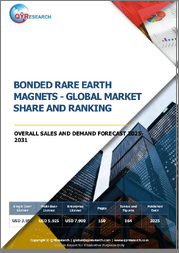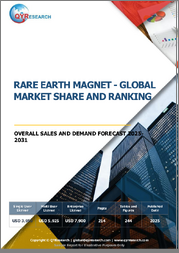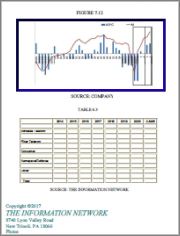
|
시장보고서
상품코드
1654490
희토류 원소 시장 규모, 점유율, 동향 분석 보고서 : 제품별, 용도별, 지역별, 부문 예측(2025-2030년)Rare Earth Elements Market Size, Share & Trends Analysis Report By Product (Dysprosium, Neodymium), By Application (Magnets, Metallurgy), By Region (North America, Europe, APAC, Central & South America, MEA), And Segment Forecasts, 2025 - 2030 |
||||||
희토류 원소 시장의 성장과 동향
Grand View Research, Inc.의 최신 보고서에 따르면 세계의 희토류 원소 시장 규모는 2030년까지 62억 8,000만 달러에 달할 것으로 예상되며, 2025-2030년간 연평균 8.6%의 성장률을 보일 것으로 예상됩니다.
전기자동차 배터리 생산에서 영구 자석의 사용 증가는 예측 기간 중 네오디뮴, 프라세오디뮴, 디스프로슘, 가돌리늄, 테르븀을 포함한 희토류 원소에 대한 수요를 촉진할 것으로 예상됩니다. 네오디뮴과 프라세오디뮴을 기반으로 한 희토류 영구 자석은 주로 배터리 제조에 사용됩니다.
중국 정부는 2019년 3월, 중국 정부의 전기자동차에 대한 보조금 삭감 조치로 인해 중국내 제조업체의 기술 혁신을 촉진하기 위해 전기자동차에 대한 보조금을 삭감하여 비용 절감을 이유로 영구자석에 대한 수요를 증가시킬 것으로 예상됩니다. 주행거리 400km 이하의 전기자동차에 대한 보조금은 5만 위안에서 2만 5,000위안으로 줄었고, 주행거리 250km 이하의 자동차에 대한 보조금은 폐지되었습니다.
USGS에 따르면 매장량은 중국이 4,400만 톤으로 가장 많고, 말레이시아가 3만 톤으로 가장 적습니다. 또한 미국은 6조 2,000억 달러 상당의 광물자원을 보유하고 있다고 합니다. 그러나 미국에서는 채굴에 대한 규제가 엄격하여 기업은 중국에서 원료를 수입할 수밖에 없습니다. 따라서 원자재 생산은 미국 기업에게 큰 도전이 되고 있습니다.
희토류 원소의 가격 상승과 신규 광산 개설을 위한 고액의 투자로 인해 제품의 재활용이 진행되고 있습니다. 일본은 희토류 재활용의 주요 생산국 중 하나이며, 2010년 히타치는 에어컨과 하드 디스크 드라이브에서 희토류 자석을 재활용하는 새로운 기술을 개발했습니다. 이 기술은 기존 방식보다 약 8배 더 효율적으로 자석을 재활용할 수 있으며, 2012년 혼다는 최초의 희토류 재활용 공장을 설립했습니다. 이 회사는 금속을 포함한 중고 자동차 부품을 이용하여 희토류를 생산했습니다.
희토류 시장의 주요 시장 진출기업은 인수, 확장 및 고객과의 장기 계약에 관여하고 있으며, 2017년 11월 Hitachi Metals Ltd는 일본의 합금 제조업체인 Santoku Corporation을 인수했습니다. 이 전략은 세계 시장에서 지속적인 성장을 달성하기 위해 네오디뮴 자석 합금의 생산을 가속화하기 위한 것이었습니다.
희토류 원소 시장 보고서 하이라이트
- 네오디뮴은 영구 자석 생산에 사용되며, 2024년 매출 점유율이 30.3%로 가장 높습니다. 네오디뮴은 주요 부문으로 예측 기간 중 8.1%의 연평균 복합 성장률(CAGR)을 나타낼 것으로 예상됩니다.
- 자석은 2024년 가장 큰 용도로 전 세계 매출 점유율의 약 41.0%를 차지했습니다.
- 아시아태평양이 지배적인 지역으로, 2024년 매출 점유율은 86%를 넘어섰습니다.
목차
제1장 조사 방법과 범위
제2장 개요
제3장 시장의 변수, 동향, 범위
- 시장 계통 전망
- 밸류체인 분석
- 제조와 기술 개요
- 규제 프레임워크
- 시장 역학
- 시장 성장 촉진요인 분석
- 시장 성장 억제요인 분석
- 시장 기회 분석
- 시장이 해결해야 할 과제
- Porter's Five Forces 분석
- 공급 기업의 교섭력
- 바이어의 교섭력
- 대체의 위협
- 신규 진출업체의 위협
- 경쟁 기업 간 경쟁 관계
- PESTLE 분석
- 정치
- 경제
- 사회
- 기술
- 환경
- 법률
제4장 희토류 원소 시장 : 제품별, 추정·동향 분석
- 희토류 원소 시장 : 제품 변동 분석, 2023년과 2030년
- Cerium
- Dysprosium
- Erbium
- Europium
- Gadolinium
- Holmium
- Lanthanum
- Lutetium
- Neodymium
- Praseodymium
- Promethium
- Samarium
- Scandium
- Terbium
- Thulium
- Ytterbium
- Yttrium
제5장 희토류 원소 시장 : 용도별, 추정·동향 분석
- 희토류 원소 시장 : 용도 변동 분석, 2023년과 2030년
- 자석
- 촉매
- 연마
- 야금
- 배터리 합금
- 유리
- 형광체
- 세라믹
- 기타
제6장 희토류 원소 시장 : 지역별, 추정·동향 분석
- 지역 분석, 2023년과 2030년
- 북미
- 제품별, 2018-2030년
- 용도별, 2018-2030년
- 미국
- 유럽
- 제품별, 2018-2030년
- 용도별, 2018-2030년
- 독일
- 영국
- 프랑스
- 아시아태평양
- 제품별, 2018-2030년
- 용도별, 2018-2030년
- 중국
- 일본
- 인도
- 중남미
- 제품별, 2018-2030년
- 용도별, 2018-2030년
- 중동 및 아프리카
- 제품별, 2018-2030년
- 용도별, 2018-2030년
제7장 경쟁 구도
- 주요 시장 참여 기업에 의한 최근 동향
- 기업 분류
- 히트맵 분석
- 기업 시장 순위
- 벤더 구도
- 기타 주요 제조업체 리스트
- 판매 대리점 리스트
- 전망 최종사용자 리스트
- 전략 지도제작
- 기업 개요/상장기업
- Lynas Corporation Ltd
- Alkane Resources Ltd
- Northern Minerals Ltd
- Arafura Resources Ltd
- Ucore Rare Metals Inc.
- Hitachi Metals Ltd.
- Shin-Etsu Chemical Co., Ltd.
- Greenland Minerals Ltd
- Iluka Resources Limited
- Indian Rare Earth Limited
- Avalon Advanced Materials Inc.
- Rare Element Resources Ltd.
- China Northern Rare Earth(Group) High-Tech Co., Ltd.
Rare Earth Elements Market Growth & Trends:
The global rare earth elements market size is estimated to reach USD 6.28 billion by 2030, registering to grow at a CAGR of 8.6% from 2025 to 2030 according to a new report by Grand View Research, Inc. The growing use of permanent magnets in the production of batteries for electric vehicles is expected to propel the demand for rare earth elements including neodymium, praseodymium, dysprosium, gadolinium, and terbium over the forecast period. Neodymium and praseodymium based rare earth permanent magnets are majorly used in the manufacturing of batteries.
The growing demand for electric vehicles coupled with the government initiatives on reducing the CO2 emissions is expected to boost the demand for permanent magnets. In March 2019, the Chinese government reduced subsidies for electric vehicles in order to promote innovation amongst local manufacturers on account of declining costs. The incentives for electric cars with less than 400 km range decreased from 50,000 yuan to 25,000 yuan, while the incentives for vehicles ranging less than 250 km have been eliminated.
According to USGS, China holds the largest amount of reserves with 44 million tons and Malaysia holds the least amount of reserves with 30 thousand tons. It also stated that the U.S. has USD 6.2 trillion worth of mineral reserves. However, the stringent regulatory policies towards mining in the U.S. has forced the companies to import the raw materials from China. Hence, the production of raw material has been a major challenge for the U.S companies.
The increasing prices of rare earth elements and high investments to open new mines have given rise to recycling of the product. Japan is one of the major producer of recycled rare earth elements. In 2010, Hitachi developed a new technology for recycling rare-earth magnets from air conditioners and hard disk drives. It can separate recycle magnets approximately eight times more efficiently than conventional methods. In 2012, The Honda Corporation opened the first rare earth recycling plant. The company utilized used automotive parts containing metals to produce rare earth elements.
The key players in the rare earth elements market are involved in acquisitions, expansions, and long term binding agreements with their customers. In Nov 2017, Hitachi Metals Ltd acquired Santoku Corporation, a Japanese manufacturer of alloys. This strategy was aimed at accelerating the production of neodymium magnet alloys in order to achieve sustainable growth in the global market.
Rare Earth Elements Market Report Highlights:
- Neodymium is used in the production of permanent magnets and accounted for the highest revenue share of 30.3% in 2024. Neodymium was the leading segment and is anticipated to witness a CAGR of 8.1% over the forecast period.
- Magnets was the largest application segment in 2024 and accounted for about 41.0% of the global revenue share.
- Asia Pacific was the dominant region, with a revenue share of over 86% in 2024.
Table of Contents
Chapter 1. Methodology and Scope
- 1.1. Market Segmentation & Scope
- 1.2. Market Definition
- 1.3. Information Procurement
- 1.3.1. Information Analysis
- 1.3.2. Market Formulation & Data Visualization
- 1.3.3. Data Validation & Publishing
- 1.4. Research Scope and Assumptions
- 1.4.1. List of Data Sources
Chapter 2. Executive Summary
- 2.1. Market Snapshot
- 2.2. Segmental Outlook
- 2.3. Competitive Outlook
Chapter 3. Market Variables, Trends, and Scope
- 3.1. Market Lineage Outlook
- 3.2. Value Chain Analysis
- 3.3. Manufacturing & Technology Overview
- 3.4. Regulatory Framework
- 3.5. Market Dynamics
- 3.5.1. Market Driver Analysis
- 3.5.2. Market Restraint Analysis
- 3.5.3. Market Opportunity Analysis
- 3.5.4. Market Challenges
- 3.6. Porter's Five Forces Analysis
- 3.6.1. Bargaining Power of Suppliers
- 3.6.2. Bargaining Power of Buyers
- 3.6.3. Threat of Substitution
- 3.6.4. Threat of New Entrants
- 3.6.5. Competitive Rivalry
- 3.7. PESTLE Analysis
- 3.7.1. Political
- 3.7.2. Economic
- 3.7.3. Social Landscape
- 3.7.4. Technology
- 3.7.5. Environmental
- 3.7.6. Legal
Chapter 4. Rare Earth Elements Market: Product Estimates & Trend Analysis
- 4.1. Rare Earth Elements Market: Product Movement Analysis, 2023 & 2030
- 4.2. Cerium
- 4.2.1. Market estimates and forecasts, 2018 - 2030 (Tons) (USD Million)
- 4.3. Dysprosium
- 4.3.1. Market estimates and forecasts, 2018 - 2030 (Tons) (USD Million)
- 4.4. Erbium
- 4.4.1. Market estimates and forecasts, 2018 - 2030 (Tons) (USD Million)
- 4.5. Europium
- 4.5.1. Market estimates and forecasts, 2018 - 2030 (Tons) (USD Million)
- 4.6. Gadolinium
- 4.6.1. Market estimates and forecasts, 2018 - 2030 (Tons) (USD Million)
- 4.7. Holmium
- 4.7.1. Market estimates and forecasts, 2018 - 2030 (Tons) (USD Million)
- 4.8. Lanthanum
- 4.8.1. Market estimates and forecasts, 2018 - 2030 (Tons) (USD Million)
- 4.9. Lutetium
- 4.9.1. Market estimates and forecasts, 2018 - 2030 (Tons) (USD Million)
- 4.10. Neodymium
- 4.10.1. Market estimates and forecasts, 2018 - 2030 (Tons) (USD Million)
- 4.11. Praseodymium
- 4.11.1. Market estimates and forecasts, 2018 - 2030 (Tons) (USD Million)
- 4.12. Promethium
- 4.12.1. Market estimates and forecasts, 2018 - 2030 (Tons) (USD Million)
- 4.13. Samarium
- 4.13.1. Market estimates and forecasts, 2018 - 2030 (Tons) (USD Million)
- 4.14. Scandium
- 4.14.1. Market estimates and forecasts, 2018 - 2030 (Tons) (USD Million)
- 4.15. Terbium
- 4.15.1. Market estimates and forecasts, 2018 - 2030 (Tons) (USD Million)
- 4.16. Thulium
- 4.16.1. Market estimates and forecasts, 2018 - 2030 (Tons) (USD Million)
- 4.17. Ytterbium
- 4.17.1. Market estimates and forecasts, 2018 - 2030 (Tons) (USD Million)
- 4.18. Yttrium
- 4.18.1. Market estimates and forecasts, 2018 - 2030 (Tons) (USD Million)
Chapter 5. Rare Earth Elements Market: Application Estimates & Trend Analysis
- 5.1. Rare Earth Elements Market: Application Movement Analysis, 2023 & 2030
- 5.2. Magnets
- 5.2.1. Market estimates and forecasts, 2018 - 2030 (Tons) (USD Million)
- 5.3. Catalysts
- 5.3.1. Market estimates and forecasts, 2018 - 2030 (Tons) (USD Million)
- 5.4. Polishing
- 5.4.1. Market estimates and forecasts, 2018 - 2030 (Tons) (USD Million)
- 5.5. Metallurgy
- 5.5.1. Market estimates and forecasts, 2018 - 2030 (Tons) (USD Million)
- 5.6. Battery alloys
- 5.6.1. Market estimates and forecasts, 2018 - 2030 (Tons) (USD Million)
- 5.7. Glass
- 5.7.1. Market estimates and forecasts, 2018 - 2030 (Tons) (USD Million)
- 5.8. Phosphors
- 5.8.1. Market estimates and forecasts, 2018 - 2030 (Tons) (USD Million)
- 5.9. Ceramics
- 5.9.1. Market estimates and forecasts, 2018 - 2030 (Tons) (USD Million)
- 5.10. Others
- 5.10.1. Market estimates and forecasts, 2018 - 2030 (Tons) (USD Million)
Chapter 6. Rare Earth Elements Market: Regional Estimates & Trend Analysis
- 6.1. Regional Analysis, 2023 & 2030
- 6.2. North America
- 6.2.1. Market estimates and forecasts, 2018 - 2030 (Tons) (USD Million)
- 6.2.2. Market estimates and forecasts, by product, 2018 - 2030 (Tons) (USD Million)
- 6.2.3. Market estimates and forecasts, by application, 2018 - 2030 (Tons) (USD Million)
- 6.2.4. U.S.
- 6.2.4.1. Market estimates and forecasts, 2018 - 2030 (Tons) (USD Million)
- 6.2.4.2. Market estimates and forecasts, by product, 2018 - 2030 (Tons) (USD Million)
- 6.2.4.3. Market estimates and forecasts, by application, 2018 - 2030 (Tons) (USD Million)
- 6.3. Europe
- 6.3.1. Market estimates and forecasts, 2018 - 2030 (Tons) (USD Million)
- 6.3.2. Market estimates and forecasts, by product, 2018 - 2030 (Tons) (USD Million)
- 6.3.3. Market estimates and forecasts, by application, 2018 - 2030 (Tons) (USD Million)
- 6.3.4. Germany
- 6.3.4.1. Market estimates and forecasts, 2018 - 2030 (Tons) (USD Million)
- 6.3.4.2. Market estimates and forecasts, by product, 2018 - 2030 (Tons) (USD Million)
- 6.3.4.3. Market estimates and forecasts, by application, 2018 - 2030 (Tons) (USD Million)
- 6.3.5. UK
- 6.3.5.1. Market estimates and forecasts, 2018 - 2030 (Tons) (USD Million)
- 6.3.5.2. Market estimates and forecasts, by product, 2018 - 2030 (Tons) (USD Million)
- 6.3.5.3. Market estimates and forecasts, by application, 2018 - 2030 (Tons) (USD Million)
- 6.3.6. France
- 6.3.6.1. Market estimates and forecasts, 2018 - 2030 (Tons) (USD Million)
- 6.3.6.2. Market estimates and forecasts, by product, 2018 - 2030 (Tons) (USD Million)
- 6.3.6.3. Market estimates and forecasts, by application, 2018 - 2030 (Tons) (USD Million)
- 6.4. Asia Pacific
- 6.4.1. Market estimates and forecasts, 2018 - 2030 (Tons) (USD Million)
- 6.4.2. Market estimates and forecasts, by product, 2018 - 2030 (Tons) (USD Million)
- 6.4.3. Market estimates and forecasts, by application, 2018 - 2030 (Tons) (USD Million)
- 6.4.4. China
- 6.4.4.1. Market estimates and forecasts, 2018 - 2030 (Tons) (USD Million)
- 6.4.4.2. Market estimates and forecasts, by product, 2018 - 2030 (Tons) (USD Million)
- 6.4.4.3. Market estimates and forecasts, by application, 2018 - 2030 (Tons) (USD Million)
- 6.4.5. Japan
- 6.4.5.1. Market estimates and forecasts, 2018 - 2030 (Tons) (USD Million)
- 6.4.5.2. Market estimates and forecasts, by product, 2018 - 2030 (Tons) (USD Million)
- 6.4.5.3. Market estimates and forecasts, by application, 2018 - 2030 (Tons) (USD Million)
- 6.4.6. India
- 6.4.6.1. Market estimates and forecasts, 2018 - 2030 (Tons) (USD Million)
- 6.4.6.2. Market estimates and forecasts, by product, 2018 - 2030 (Tons) (USD Million)
- 6.4.6.3. Market estimates and forecasts, by application, 2018 - 2030 (Tons) (USD Million)
- 6.5. Central & South America
- 6.5.1. Market estimates and forecasts, 2018 - 2030 (Tons) (USD Million)
- 6.5.2. Market estimates and forecasts, by product, 2018 - 2030 (Tons) (USD Million)
- 6.5.3. Market estimates and forecasts, by application, 2018 - 2030 (Tons) (USD Million)
- 6.6. Middle East & Africa
- 6.6.1. Market estimates and forecasts, 2018 - 2030 (Tons) (USD Million)
- 6.6.2. Market estimates and forecasts, by product, 2018 - 2030 (Tons) (USD Million)
- 6.6.3. Market estimates and forecasts, by application, 2018 - 2030 (Tons) (USD Million)
Chapter 7. Competitive Landscape
- 7.1. Recent Developments, By Key Market Participants
- 7.2. Company Categorization
- 7.3. Heat Map Analysis
- 7.4. Company Market Ranking
- 7.5. Vendor Landscape
- 7.5.1. List of Other Prominent Manufacturers
- 7.5.2. List of Distributors
- 7.6. List of Prospective End-Users
- 7.7. Strategy Mapping
- 7.8. Company Profiles/Listing
- 7.8.1. Lynas Corporation Ltd
- 7.8.1.1. Company Overview
- 7.8.1.2. Financial Performance
- 7.8.1.3. Product Benchmarking
- 7.8.2. Alkane Resources Ltd
- 7.8.2.1. Company Overview
- 7.8.2.2. Financial Performance
- 7.8.2.3. Product Benchmarking
- 7.8.3. Northern Minerals Ltd
- 7.8.3.1. Company Overview
- 7.8.3.2. Financial Performance
- 7.8.3.3. Product Benchmarking
- 7.8.4. Arafura Resources Ltd
- 7.8.4.1. Company Overview
- 7.8.4.2. Financial Performance
- 7.8.4.3. Product Benchmarking
- 7.8.5. Ucore Rare Metals Inc.
- 7.8.5.1. Company Overview
- 7.8.5.2. Financial Performance
- 7.8.5.3. Product Benchmarking
- 7.8.6. Hitachi Metals Ltd.
- 7.8.6.1. Company Overview
- 7.8.6.2. Financial Performance
- 7.8.6.3. Product Benchmarking
- 7.8.7. Shin-Etsu Chemical Co., Ltd.
- 7.8.7.1. Company Overview
- 7.8.7.2. Financial Performance
- 7.8.7.3. Product Benchmarking
- 7.8.8. Greenland Minerals Ltd
- 7.8.8.1. Company Overview
- 7.8.8.2. Financial Performance
- 7.8.8.3. Product Benchmarking
- 7.8.9. Iluka Resources Limited
- 7.8.9.1. Company Overview
- 7.8.9.2. Financial Performance
- 7.8.9.3. Product Benchmarking
- 7.8.10. Indian Rare Earth Limited
- 7.8.10.1. Company Overview
- 7.8.10.2. Financial Performance
- 7.8.10.3. Product Benchmarking
- 7.8.11. Avalon Advanced Materials Inc.
- 7.8.11.1. Company Overview
- 7.8.11.2. Financial Performance
- 7.8.11.3. Product Benchmarking
- 7.8.12. Rare Element Resources Ltd.
- 7.8.12.1. Company Overview
- 7.8.12.2. Financial Performance
- 7.8.12.3. Product Benchmarking
- 7.8.13. China Northern Rare Earth (Group) High-Tech Co., Ltd.
- 7.8.13.1. Company Overview
- 7.8.13.2. Financial Performance
- 7.8.13.3. Product Benchmarking
- 7.8.1. Lynas Corporation Ltd
(주말 및 공휴일 제외)


















